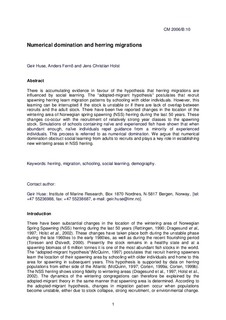| dc.contributor.author | Huse, Geir | |
| dc.contributor.author | Fernö, Anders | |
| dc.contributor.author | Holst, Jens Christian | |
| dc.date.accessioned | 2007-06-21T10:38:30Z | |
| dc.date.issued | 2006 | |
| dc.identifier.uri | http://hdl.handle.net/11250/100891 | |
| dc.description.abstract | There is accumulating evidence in favour of the hypothesis that herring migrations are influenced by social learning. The “adopted-migrant hypothesis” postulates that recruit spawning herring learn migration patterns by schooling with older individuals. However, this learning can be interrupted if the stock is unstable or if there are lack of overlap between recruits and the adult stock. There have been five reported changes in the location of the wintering area of Norwegian spring spawning (NSS) herring during the last 50 years. These changes co-occur with the recruitment of relatively strong year classes to the spawning stock. Simulations of schools containing naïve and experienced fish have shown that when abundant enough, naïve individuals repel guidance from a minority of experienced individuals. This process is referred to as numerical domination. We argue that numerical domination obstruct social learning from adults to recruits and plays a key role in establishing new wintering areas in NSS herring. | en |
| dc.format.extent | 59519 bytes | |
| dc.format.mimetype | application/pdf | |
| dc.language.iso | eng | en |
| dc.publisher | ICES | en |
| dc.relation.ispartofseries | ICES CM documents | en |
| dc.relation.ispartofseries | 2006/B:10 | en |
| dc.subject | herring | en |
| dc.subject | sild | en |
| dc.subject | fish migration | en |
| dc.subject | vandringer | |
| dc.title | Numerical domination and herring migrations | en |
| dc.type | Working paper | en |
| dc.subject.nsi | VDP::Mathematics and natural science: 400::Zoology and botany: 480::Ethology: 485 | |
| dc.subject.nsi | VDP::Agriculture and fishery disciplines: 900::Fisheries science: 920 | |
| dc.source.pagenumber | 5 s. | en |
